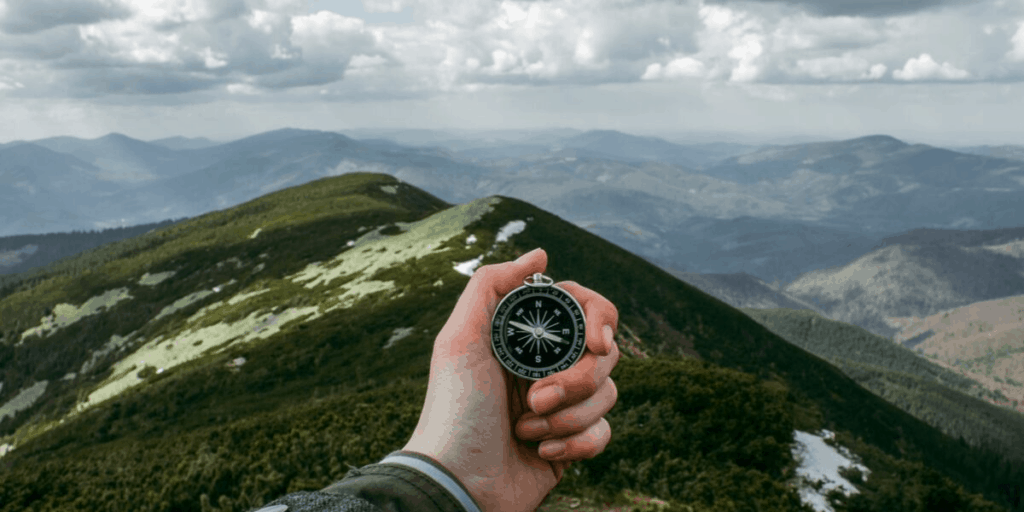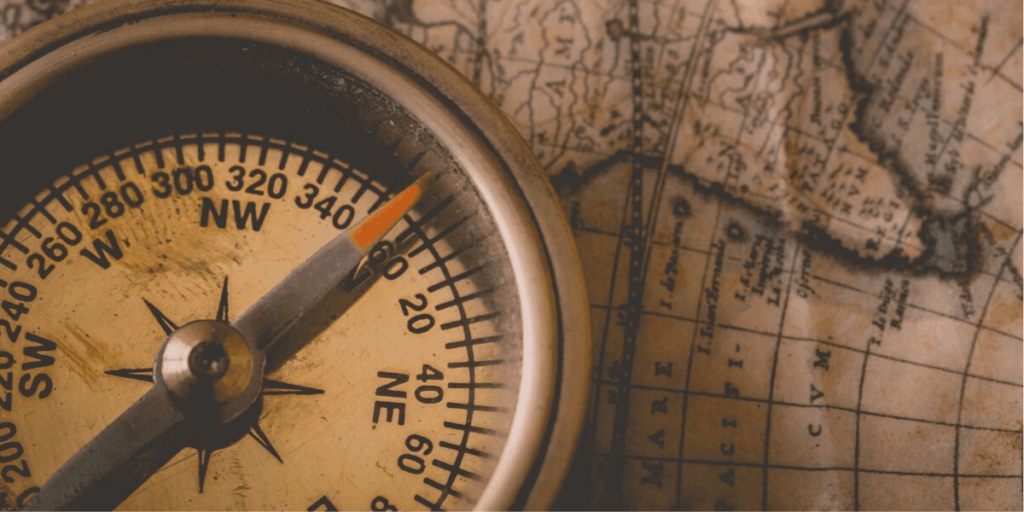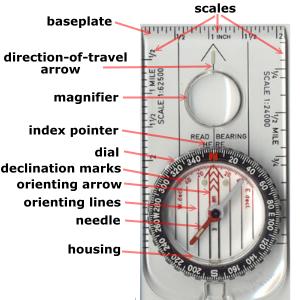Last Updated on April 26, 2023 by Lisa Vargas
Knowing how to navigate with a map and a compass could end up saving your life one day and is a crucial part of a prepper’s planning. If you are anything like me, if the shtf in my area, I would head straight for the mountains (along with everyone else in the central valley I’m sure). But I would have a distinct advantage over most city-dwellers because even though I live in an urban environment now, I grew up in the mountains and continue to “play” in the mountains to this day. Having the best compass for survival will greatly increase your odds of surviving the zombie apocalypse.
I always remember having a compass and paper maps in our camping gear, just in case we got lost I figured. My father is a huge outdoorsman, and would never leave home with something like that. Today, there are fancy GPS apps that you can download to your smartphones, but I would never trust your iPhone battery to get you through a survival situation.
Knowing how to properly use a compass and map to navigate your way around an unfamiliar city, landscape, or the wilderness is a crucial part of your survival skills. So today, we are going to learn what to look for in a survival compass and then determine the best compass for survival.
So let’s jump right in!
What to look For In A Good Survival Compass

To begin, keep in mind that there are several different types and models of compasses such as baseplate, sighting, prismatic, and electronic. But to keep it simple today, we are going to stick with looking at one of the most common, and more inexpensive types which is the baseplate compass.
When you are analyzing compasses, here’s some things to keep in mind:
- Do you want a digital or an analog compass? – Compasses are either analog or digital. Digital compasses are battery operated and will display the coordinates in numbers, and use sensors to determine the magnetic field around them in order to report those numbers. The analog compass uses the magnet needle with the red point and points to magnetic north. These are the classic compasses you are used to seeing. And these are great for being in more familiar territory, but if you find yourself in an unfamiliar place, I would suggest going with the digital compasses because it’s a little easier to use and keep steady.
- Does the compass you are choosing have a declination adjustment screw? – You need to have the ability to have the compass adjust between true north and magnetic north. With the declination adjustment feature, the compass will automatically adjust for you. The reason that this is important is because if your compass is following the magnetic north instead of the true north, on long journeys it could really throw you off of your destination for miles. You will fare better in short distances because you have to understand that the angles are changing all of the time depending on where you are. So make sure you understand the risks of picking up a compass without the declination adjustment feature.
- Does your compass have a sighting mirror? Sighting mirrors are a little more advanced, but they certainly allow you to be a little more aware of your surroundings because you can see behind you as you are navigating. It also let’s you create slightly more accurate readings.
- Does your compass have a back light? Since you may be in a situation where there is no electricity and you are forced to navigate at night, having a compass that has a back light is a smart idea. So if this is something you value, you can buy a compass that provides that, or else bring a flashlight with you!
- Is your compass a dry needle or a floating needle compass? You will notice that some compasses have a dry needle and some have a floating needle. In my humble opinion, the floating needle compass is more accurate because the liquid inside is designed to keep the needle more stable from shaky hands.
- Is your compass rugged and durable enough? If you are in the wilderness hunting, fishing, or hiking because your life depends on it, most likely you are going to run into conditions that aren’t going to always be so bright and sunny. Make sure your compass is waterproof and can stand up to a few rough and tumbles along the way.
Compass Parts

Let’s look at the important aspects of a compass that you need to keep in mind. There are several features of a compass that should be looked at when you are getting started with your research. With the help of North Carolina State University Research on Basic Land Navigation, you will find the descriptions of the parts of a compass below:
- Declination Adjustment – Declination, described by REI as the difference between magnetic north and true north, is a huge part of the success of any navigational compass. You will want a compass that have a declination screw that can be turned for proper declination. All compasses are automatically set to magnetic north. You must adjust them using the declination adjustment screw for more accurate readings.
- Sighting Mirror – Some of the compasses that you will find have flip up mirrors that have the ability to make the accuracy a lot better when you are reading bearings. You will want to read the bearing in the dial’s reflection where the mirror line crosses it. You can also use the sighting mirror for signaling.
- Clinometer– A clinometer is essentially used for measuring slopes of things like hills and mountains. It can also be used to measure elevation of an object in respect to gravity. Not all compasses will have them, but the better built ones will.
- Magnetic Needle – The magnetic needle will typically have a red end that points to magnetic north. But keep in mind that this isn’t always the case if you aren’t using it correctly or if there is any other magnetic attractions nearby. Also note that your magnetic needle may work in the U.S. but if you take your compass to New Zealand, it won’t be worth much to you. That’s because compasses are typically calibrated for the magnetic variances in your country or even hemisphere to be more exact.
- Magnifying Lens – This can come in handy when you need to read really small writing on a map.
- Base Plate – The base plate is what everything else is attached to. It acts as a ruler as you are sliding it along a map, for example. The direction of the travel arrow is also located in the baseplate. You can also find some compasses that have a protractor that be used for determining bearings on a map.
- Index Line – This is where you will read the indicated bearing.
- Orienting Lines – The north-south orienting lines parallel the orienting arrow and can be used to line up the compass dial with grid lines on a map. When the declination is set on a compass with an adjustment screw, the orienting lines no longer parallel the orienting arrow (Source: Basic Land Navigation, NCSU).
- Orienting arrow – The north-south orienting arrow is used to align the magnetic needle when taking a bearing. This orienting arrow is also adjusted when setting up a compass for magnetic declination.
- Housing with cardinal points and degrees – The housing will include the dial that shows the north, east, south, and west plus the degrees (typically 0-360). The housing is rotated to line up with the compass needle with the orienting arrow when taking your bearing.
Please note that the picture above may include the basic compass parts. Some compasses have less and some have much more. It will depend on how much you want to spend because as you can imagine the more features you would like, the more money you will pay.
Best Compass For Survival
Now that we know all of the basics of a compass such as the parts of a compass and what to look for in a good compass, let’s get right into to finding the best survival compass for your prepping plans.
CMMG Official US Military Tritium Lensatic Compass
This lensatic compass, commonly referred to as the military compass, is the first on our list of best survival compasses because of its pure ruggedness and durability and advanced capabilities. At its core, its essentially a dry needle magnetic compass, with more advanced features. The word “lensatic” is referring to the magnetic lens that makes it much easier to use.
With the protective case on this compass, it makes it more durable so that if you have it thrown in your bug out bag it can withstand a greater beating than others.
The manufacturer, Cammenga, is well known for producing navigation equipment and contracting with the U.S. military and the marine corpse. This is the civilian-issued version of the US military M-1950 3H field compass. Cammenga, founded in 1992, is based in Holland, Michigan and is known for their high-quality outdoor products, which is why I added this compass as one of the more durable and reliable compasses on the market.
Pros
- Tritium micro lighting stays active for 12 years
- Aluminum frame and waterproof housing
- 1 year warranty
- Air-filled housing so no bubbles
- Precise and easy to use
- Built to satisfy US Military’s demanding standards (MIL-PRF-10436N)
Cons
- Site wire is slightly crooked
- Rotating bezel reported by some to be a bit flimsy
- Doesn’t have a global needle, therefore you can only use in the U.S.
- Isn’t suited for topo maps, since it is limited to a 1:50,000 metric scale
- No magnetic declination adjustment
SUUNTO M-3 G Compass
LThis Finland made compass by Suunto, is one of my favorites as its durable, is encased in plastic, has declination adjustment, and can be warn around your neck at all times. If you’re not familiar with the Suunto brand name, they make everything from sports watches, dive products, to compasses that we are discussing today. This particular Suunto compass is a best seller on Amazon, is compact and light-weight and makes for a great survival compass.
- Declination adjustment: Yes
- Liquid filled capsule: Yes
- Metric and imperial scales
- Product dimensions: 1 x 2 x 2 inches
- Luminescent bezel and needle
- Global needle: Yes
- Includes clinometer
- Balanced to southern hemisphere
The Suunto M-3 G compass is fantastic for hiking in the mountains and great if you use it additionally with a map. You will notice on the compass that it has a metric scale (cm/mm) on one side and inches on the other so you can measure distances from certain points. This is a fantastic backup navigation system just in case you have a GPS that goes bad while on the move.
Pros
- No metal parts so no rusting
- Durable and rugged
- Completely waterproof
- Lightweight
- Incredibly reliable and accurate readings
- Has a unique sighting system that is extremely accurate
Cons
- The wide bezel can make it a little difficult to take accurate readings
- Its been reported a few times that the declination angle can come out of adjustment sometimes.
Eyeskey Multifunctional Military Metal Sighting Navigation Compass with Inclinometer
This Eyeskey multi-functional compass is an Amazon Choice product and is made for outdoors and hiking alike. The clinometer allows you to measure inclines, slope angles, and elevation, which is vital if you are stuck out in the wilderness for some time. This is considered a pro compass, and may not be best suited for novices who aren’t familiar with using compasses.
We just love this compass because of its built in bubble level, the fact it has a clinometer to measure elevation and slope angles, and has an awesome magnifying glass. It even has a tripod screw hole so you can can keep it more steady while taking readings.
Pros
- Comes with nylon pouch and lanyard
- Heavy-duty and durable
- Luminous dial
- Lifetime warranty on all defective items or parts
Cons
- Manual that comes with it isn’t that informative.
- No adjustable declination
- Heavier than other compasses
Suunto MC-2G In Global Compass
I’m excited to have gotten to the Suunto MC-2G global compass as it is my top pick for the best survival compass on the market today. This model is definitely more advanced than its sister model the M-3 G, and you will the features that it provides such as the global needle, declination adjustment, sighting hole, and much more. This is by far one of the best survival compasses on the market as you can take it with you anywhere because it’s lightweight and provides a distinctly accurate reading at every angle.
Its interesting to note that this is the inch/mile version. What that means is that it has one scale that measure 1:24000 (1 inch=24,000 inches) and one scale that measures 1:62,500 (1 inch = 62,500 inches – which is about 1 mile).
Pros
- Easy to read in the dark
- Mirror sighting can be used for signaling
- Liquid filled capsule for extreme accuracy
- Clinometer included to measure angles
- Waterproof
Cons
- Does not come with protective case
- Lots of force needed to snap the front cover closed
- The mirror doesn’t appear to be made out of glass and has been reported to corrode easily
Silva Ranger 515 Compass
The Silva Ranger 515 compass is designed for superior accuracy and comes with a liquid filled needle and is encased in plastic, which is the best setup you could get in a compass. Plastic won’t rust like metal will and the liquid surrounding the needle helps stabilize any vibrations from your hand movements.
This will be a great little compass that will last you for years. It’s been reported that this compass can last as long as 35 years, which to be honest, can be unusual for some of the modern, cheap compasses that they have on the market today. There are three Silva Compass models on the market today and all of them are very good choices if you’re forced to read maps and navigate unknown landscapes.
Pros
- Great for topographical maps
- Three different romer scales
- Silicon “feet” help keep compass from sliding along the map
- Compass is waterproof
Cons
- A bit pricier than most, but better quality and more options than most
- No global needle
- Does not come with carrying case
- Some complaints about the bezel being too loose.
Conclusion
Based on all of the reviews above, our winner today is the Suunato MC-2G In Global Compass. It provides the best overall bang for your buck and provides incredible accuracy and durability and will be suited well in a survival situation. Let us know below if you have a favorite compass that you recommend for outdoors.






